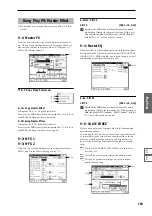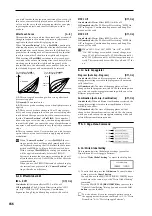
161
Global
P0
P1
P2
P3
P4
P5
P6
1–1: MIDI
Here you can make MIDI-related settings that affect the
entire TRITON Extreme.
1–1a: MIDI Setup
MIDI Channel (Global MIDI Channel)
[1…16]
Sets the global MIDI channel.
The global MIDI channel is used in the following cases.
• When transmitting and receiving performance data in
Program mode (Program P0: Play) and Sampling mode.
• When selecting combinations via MIDI in Combination
mode (Combination P0: Play).
• When controlling timbres or effects that have been set to
Gch
in various modes
• When transmitting and receiving system exclusive
messages
MIDI received
In Program mode (P0: Play), MIDI data is received on the
global MIDI channel, but in Combination mode (P0: Play) or
Sequencer mode, MIDI data is received on the MIDI channel
specified for each timbre or track.
In Combination mode (P0: Play), program changes received
on the global MIDI channel will switch the combination
(
☞
1–1b: MIDI Filter).
Use the global MIDI channel to switch IFX 1–5, MFX1 and MFX2
on/off.
To control the pan following IFX, sends 1/2, MFX 1/2 and
MEQ, use the global MIDI channel when in the Program or
Sampling mode; while in the Combination, Sequencer, or
Song Play modes, use the channel specified separately by
“Ctrl Ch” for IFX1–5, MFX1, MFX2, and MEQ. By setting
“Ctrl Ch” to Gch, you can control these parameters from the
global MIDI channel.
MIDI transmission when TRITON Extreme’s controllers are
operated
In Program mode and Sampling mode, this data will be
transmitted on the global MIDI channel. In Combination
mode, data will be transmitted simultaneously on the global
MIDI channel and on the MIDI channels of timbres whose
“Status” (Combination 0–1c, 2–1b) is set to EXT or EX2.
In Sequencer mode, musical data will be transmitted on the
channel specified for the currently selected track (Sequencer
0–1a) (whose “Status” is BTH, EXT, or EX2).
Local Control On
Checked (Local Control On):
The TRITON Extreme’s inter-
nal tone generator will be controlled by its own keyboard,
joystick, SW1 and SW2, and connected foot pedal. If you are
playing the TRITON Extreme by itself, leave this setting
checked.
Unchecked (Local Control Off):
The TRITON Extreme’s
keyboard and joystick etc. will be disconnected from the
internal tone generator.
This means that operating the TRITON Extreme (playing its
keyboard and using the joystick, or playing back the
sequencer) will not sound its internal tone generator.
Uncheck this setting if echo-back from an external sequencer
causes notes to be sounded in duplicate.
Even if this setting is unchecked, MIDI transmission
and reception will occur normally. Playing the key-
board will cause the corresponding note data to be
transmitted, and received note data will sound the TRI-
TON Extreme’s internal tone generator.
Note Receive (Note Receive Filter)
[All, Even, Odd]
This setting specifies whether even-numbered, odd-num-
bered, or all note numbers will be sounded when note data
is received from the TRITON Extreme’s keyboard or from an
external MIDI device. By connecting the TRITON Extreme
to another TRITON Extreme and setting one instrument to
Even
and the other to Odd, you can effectively double the
polyphony by dividing the notes between the two instru-
ments.
All:
All note numbers will be received. Normally you will
leave this set to All.
Even:
Even-numbered notes (C, D, E, F#, G#, A#) will sound.
Odd:
Odd-numbered notes (C#, D#, F, G, A, B) will sound.
This setting has no effect on the MIDI data that is
received.
Convert Position
[PreMIDI, PostMIDI]
This setting specifies the location at which the Transpose,
Velocity Curve, and After Touch Curve settings will be
applied. This setting will affect the MIDI data that is trans-
mitted and received, and the data that is recorded on the
internal sequencer.
When using the TRITON Extreme’s keyboard to play the
internal tone generator, the Transpose, Velocity Curve, and
After Touch Curve settings will always take effect regardless
of this setting.
PreMIDI:
Velocity Curve, After Touch Curve, and Trans-
pose will be applied to the data that is transmitted from the
TRITON Extreme’s keyboard.
This means that the Velocity Curve, After Touch Curve, and
Transpose settings will affect the data that is transmitted
from MIDI OUT when the TRITON Extreme’s keyboard is
played, and the data that is recorded on the internal
Global P1: MIDI
1–1
1–1a
1–1b
MIDI IN
MIDI OUT
Record
Sequencer Arpeggiator
Local
control
OFF
ON
Trigger
Tone
generator
ODD
EVEN
Another TRITON Extreme
MIDI OUT — MIDI IN
Summary of Contents for TRITON Extreme
Page 1: ...2 E ...
Page 11: ...xii ...
Page 111: ...100 9 5 Page Menu Command 0 1A 0 1I 0 1J Program 9 5A ...
Page 185: ...174 ...
Page 215: ...204 ...
Page 281: ...270 ...
Page 349: ...338 ...
Page 350: ...339 ...
Page 351: ...340 ...
Page 352: ...341 ...
Page 353: ...342 ...






























